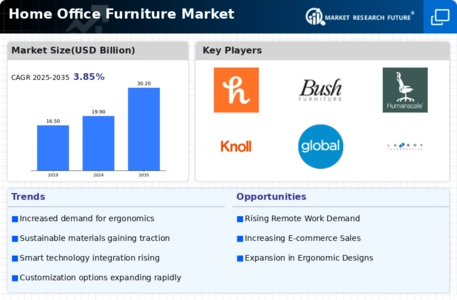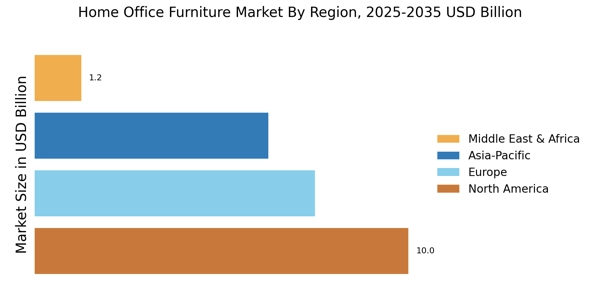The Home Office Furniture Market is currently characterized by a dynamic competitive landscape, driven by evolving consumer preferences and the increasing importance of ergonomic and multifunctional designs. Major players such as Herman Miller (US), Steelcase (US), and IKEA (SE) are at the forefront, each adopting distinct strategies to enhance their market positioning. Herman Miller (US) emphasizes innovation in design and sustainability, while Steelcase (US) focuses on research-driven solutions that cater to the changing needs of remote workers. IKEA (SE), on the other hand, leverages its extensive global supply chain to offer affordable yet stylish options, appealing to a broad demographic. Collectively, these strategies contribute to a competitive environment that is increasingly focused on quality, functionality, and consumer engagement.
In terms of business tactics, companies are increasingly localizing manufacturing to reduce lead times and enhance supply chain resilience. This trend is particularly evident in the context of a moderately fragmented market structure, where key players exert considerable influence. The collective actions of these companies indicate a shift towards optimizing supply chains and enhancing customer experiences, which are critical in maintaining competitive advantage.
In August 2025, Herman Miller (US) announced a partnership with a leading technology firm to integrate smart technology into their office furniture lines. This strategic move is likely to enhance user experience by providing customizable workspace solutions that adapt to individual preferences, thereby reinforcing Herman Miller's commitment to innovation and user-centric design.
In September 2025, Steelcase (US) launched a new line of sustainable office furniture made from recycled materials. This initiative not only aligns with global sustainability trends but also positions Steelcase as a leader in eco-friendly solutions, appealing to environmentally conscious consumers. The strategic importance of this launch lies in its potential to attract a growing segment of the market that prioritizes sustainability in their purchasing decisions.
In July 2025, IKEA (SE) expanded its product range to include modular office solutions that cater to the needs of small businesses and home offices. This expansion reflects IKEA's strategy to tap into the burgeoning market for flexible workspaces, which is increasingly relevant in today's work environment. By offering versatile and affordable solutions, IKEA is likely to strengthen its market presence and appeal to a diverse customer base.
As of October 2025, the competitive trends in the Home Office Furniture Market are increasingly defined by digitalization, sustainability, and the integration of artificial intelligence. Strategic alliances are becoming more prevalent, as companies seek to enhance their technological capabilities and product offerings. Looking ahead, it appears that competitive differentiation will evolve from traditional price-based competition to a focus on innovation, technology integration, and supply chain reliability. This shift suggests that companies that prioritize these aspects will likely emerge as leaders in the market.


















Leave a Comment